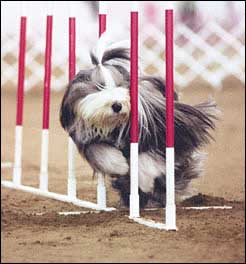Dog Agility Experts

How do you become an expert at something? First, you have to be tackling a well-defined task; second, you need to be motivated to improve; third, you must have plenty of opportunity to practice; and lastly, you must receive feedback along the way, in order to improve.
As you’re reading that description, perhaps you’re picturing piano playing, or making free throws, or the Sunday New York Times crossword puzzle. But when we read that definition of expertise, we immediately think of dog agility. Turns out we’re not alone.
Researcher William S. Helton, the author of Canine Ergonomics: The Science of Working Dogs has been studying dog agility for the past few years in an attempt to better understand the human acquisition of skills, mastery and expertise. As Helton notes:
An advantage of investigating agility is that it involves two simultaneous tasks: control of motor movement and the detection/recognition of handler signals… Expert and novice dogs are predicted to significantly differ on objective measures of skill in agility performance. In particular, expert dogs will differ in their capacity to correctly detect handler signals while simultaneously controlling their movements.
In his research, Helton has worked with groups of dogs divided into four categories: Novice, Intermediate, Advanced, and Expert, with regard to dog agility accomplishments. He studied both motor control (i.e. how well the dog navigates the agility course without faults) and signal detection (i.e. how well the dog responds to hand or verbal signals from the handler).
With motor control, he saw the greatest degree of marked improvement between the Novice and the Intermediate groups. This corresponds precisely to what we observe daily at the Zoom Room in our agility training classes.
As dogs and their owners graduate from Agility 1 to Agility 2, from week to week we witness the acquisition of muscle memory. What was once a casual jog through widely-spaced weave poles gradually builds to a deliberate, fully intentional sprint through the weave poles, with the dog’s eyes on the prize, and without any hesitation or checking in with the owner. Anyone who has performed any sport – from basketball to running – knows what this moment is like. That moment when self-consciousness slips away and what Helton refers to as “automaticity” kicks in.
Even after a mere six weeks, the transformation from dog agility novices toward dog agility experts is evident to everyone watching the practice sessions. Dogs who once had to be carefully baited through the obstacles with treats or toys are now imbued with increasing levels of mastery. It’s really something beautiful to behold!
In terms of signal detection, Helton witnessed the greatest changes between the Advanced and the Expert groups. This, too, corresponds to our own anecdotal experience. That kind of keen responsiveness to the owner’s subtle gestures and positioning is something that you don’t really see until the dogs have come out of Agility 3. Those dog agility experts have long since mastered the muscle memory for A frame, teeter, dog walk, chutes, jumps, and weave poles, deftly able to zip through any course configuration we can design. Now, in this final stage, there is that subtle yet significant last quantum leap forward as the agility dogs learn to practically read their owners’ minds, anticipating commands almost before they are uttered.
We’re thrilled that Helton and his colleagues have been studying dog agility as a means to better understand what it means to be an expert. As dog agility experts and dog lovers ourselves, we know what every dog owner inuitively understands: namely, how much we stand to learn from our pets:
- Communication between comrades can grow into something approaching telepathy;
- Obstacles that seem formidable can and will be overcome and mastered; and
- Practice makes perfect.


Leave a comment